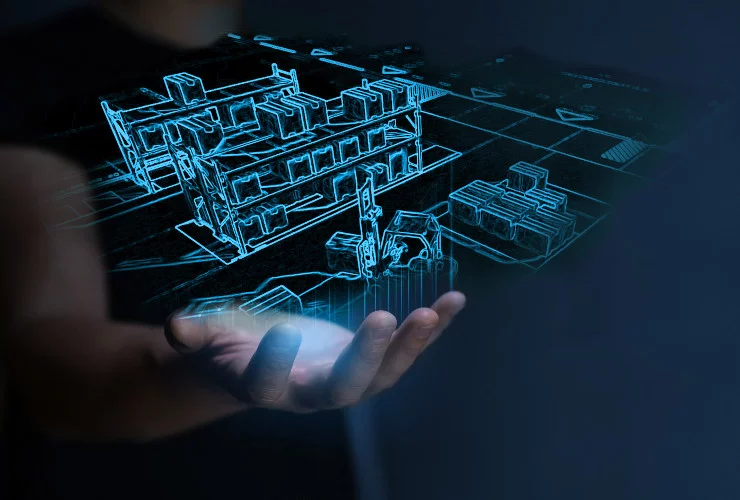As the clock ticks towards the moment when the IFOY Awards are handed out in Dortmund on June 22nd, we continue our look at all of the 2023 finalists and share the verdict from the IFOY test conducted during the evaluation by an expert jury in March. Our next entry is the Warehouse Execution System from IdentPro.
Category: Intralogistics Software
IFOY Test Report
Not only the increasing shortage of employees, but also the global challenges of the supply chain are increasing the pressure on automation in intralogistics. While significant levels of automation have already been achieved in the production processes, there is still great potential in the connected warehouses. The IdentPro digitisation solution creates the necessary prerequisite for this. A digital twin is created in real time (RTLS), in which every single transport of a good is consistently and automatically tracked to the centimetre using Lidar technology. For this purpose, all existing vehicles (manned, automated, manufacturer-independent) are equipped with IoT sensor technology, which thus permanently record up-to-date 3D information about the movement of the stored goods as well as the surrounding spatial geometry.
Via Wi-Fi or LTE, the system is in constant exchange with all the industrial trucks in use. This allows empty runs, search times and inefficient storage scenarios to be analysed. This data forms the input for intelligent algorithms. Intelligent allocation of driving jobs in real time with efficiency increases of between 20% and 30% are the result.
The IoT solution has several USPs that stand out in interaction with each other: real-time digital twin of the warehouse (RTLS), centimetre-precise localisation (+/-10cm) of goods and vehicles, collaborative use of autonomous and manned industrial trucks, and smart distribution of driving orders (SLS). All this is combined in the software solution, which ensures transparency and overall system effectiveness in intralogistics through interfaces and standards (such as omlox and VDA 5050). Connections to ERP systems or WMS are additionally possible at any time.
The Warehouse Execution System, in combination with reliable laser technology, generates complete transparency in real time. In contrast to other solutions via RFID, UWB or camera, the IdentPro solution is characterised by the centimetre and millisecond accurate creation of the digital twin. The use in open areas can be realised without further ado. Furthermore, the solution does not require any change in the infrastructure of the warehouse. Only the existing industrial trucks need to be equipped with IoT sensor technology. The software can be used directly in the inventory.
IFOY test verdict: With the digital twin in real time, IdentPro sustainably increases the overall system effectiveness of intralogistics. The warehouse execution system creates full transparency, ensures inventory security and error-free deliveries, increases efficiency, navigates loaded and unloaded vehicles in collaborative use, and can be used indoors and outdoors. Based on the complete data situation, not only does productivity increase, but the basis for smart automation is also created. Only with the twin technology can both unmanned and manned vehicles be orchestrated and controlled from one system. The supplier’s Warehouse Execution System fits seamlessly into the user’s circumstances and leads to efficiency increases of up to 30%.
IFOY Innovation Check
Market relevance: A high market relevance is seen for the presented solution of the Warehouse Execution System. The mapping of warehouse geometry, including the localisation of various manned and unmanned material handling vehicles, is useful in a wide range of sectors, as an increasing shortage of skilled workers is to be expected across the board. The approach of IdentPro GmbH can be an essential component to advance digitalisation in a company with an increase in efficiency or even to introduce it in the first place, which results in a large number of potential customers.
Customer benefit: By using the Warehouse Execution System, customers can achieve a significant increase in efficiency and at the same time enable and control the use of autonomous vehicles. Depending on the requirements, savings in personnel are then possible without detaching the warehouse employees or operators of manned industrial trucks from the warehouse processes. The digital image of the warehouse includes not only the vehicles but also the warehouse stock and thus provides full transparency, whereby the individual transport orders can be processed efficiently and comprehensibly in real time. The most flexible possible implementation of the system at the customer’s site, independent of the warehouse layout, makes it very easy to achieve the customer benefits, such as the avoidance of errors or empty runs and thus the increase potential in efficiency.
Novelty / Innovation: The generation and utilisation of a digital twin in this practice-oriented manner, with the implementation of a wide variety of material handling equipment and warehouse management, undoubtedly has a high degree of innovation. The uncomplicated possibility of applying the system to existing warehouses and optimising and monitoring the transport routes calculated in real time, as well as integrating stock and orders, appears to be a sensible new approach to meeting the increasing demands in terms of market leadership.
Functionality / Type of implementation: The system’s processes were impressively demonstrated. It became clear that the use of sensors was reduced to a sensible minimum, which makes the integration of existing vehicles relatively simple. Similarly, the determination of the transport routes was realised in a practice-oriented manner via optimisation algorithms, for example with the target value of minimum time.
Verdict: A worthy IFOY nominee with a clear market lead.
Market relevance +
Customer benefit ++
Novelty / Innovation +
Functionality / Type of implementation ++
[KEY: ++ very good / + good / Ø balanced / – less / — not available]







